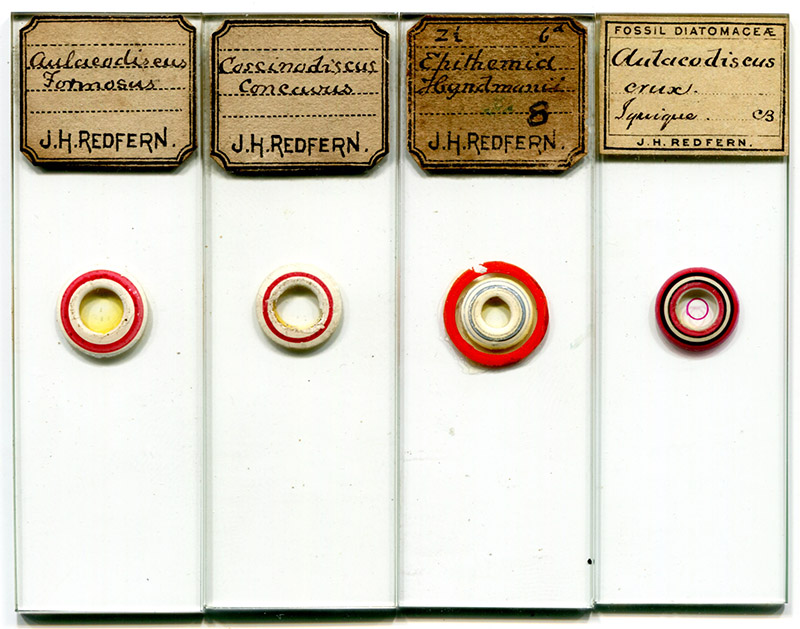
Figure 1. Microscope slides of diatoms, by James H. Redfern. The "C B" on the right slide’s label indicates that Redfern used Canada balsam as the moutant.
James Howard Redfern, 1838 - 1922
by Brian Stevenson
last updated August, 2019
Microscope slides by J.H. Redfern are encountered occasionally, and are generally nice mounts of selected diatoms (Figures 1 and 2). However, he does not appear to have left many other records of his interests in microscopy.

Figure 1.
Microscope slides of diatoms, by James H. Redfern. The "C B" on the right slide’s label indicates that Redfern used Canada balsam as the moutant.
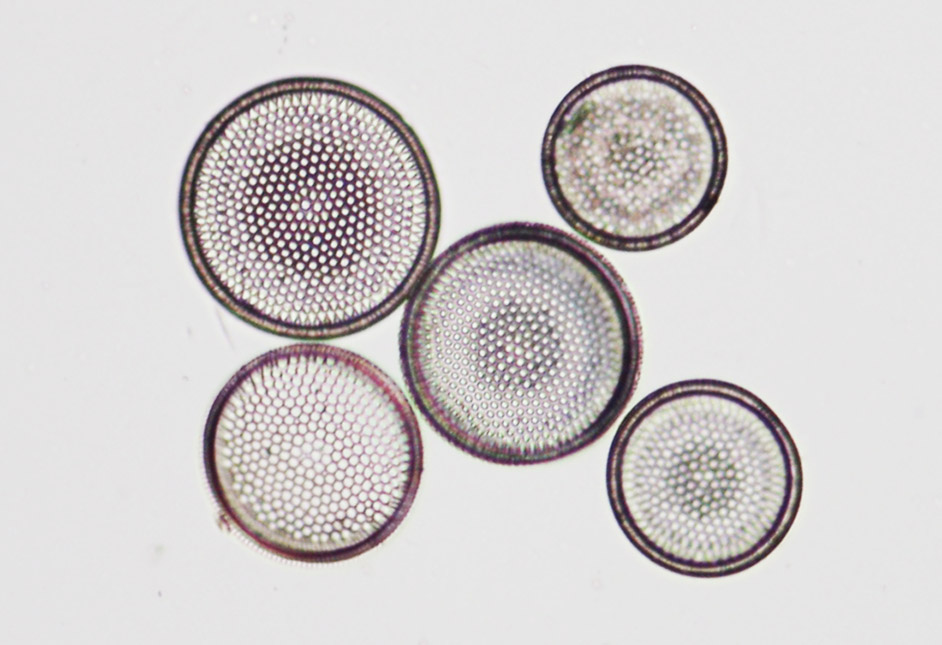
Figure 2.
An arrangement of Coscinodiscus concavus diatoms, by James Redfern (the center slide in Figure 1).
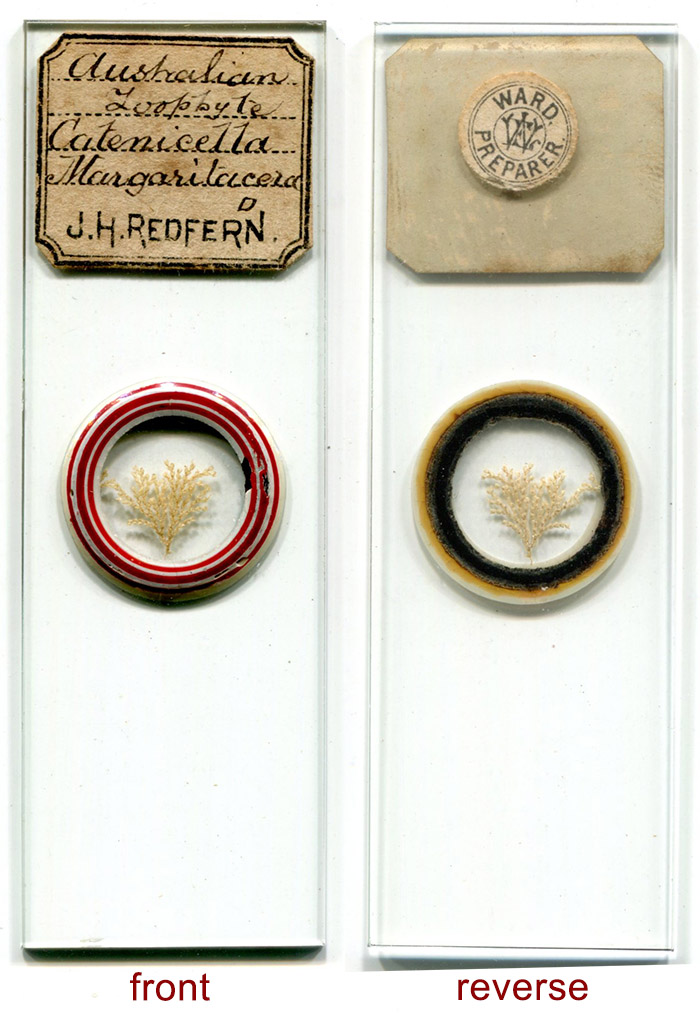
Figure 3.
A microscope of an Australian zoophyte, with Redfern’s label. This is an unusual subject for him. The reverse of the slide has a label from professional slide-maker Edward Ward, implying that Redfern likely bought this slide from Ward, then attached his own label to maintain uniformity of his slide collection. Both Redfern and Ward lived in Manchester.
Many other Victorian microscopists published advertisements or exchange offers in popular science magazines such as Hardwicke’s Science-Gossip or The English Mechanic, through which they acquired new material while also distributing their preparations to other people’s collections. Such publications are useful to modern historians for tracking down addresses and gaining insight on people’s scientific interests. To date, only one exchange request from Redfern has been identified, from 1875, which misspelled his name as “Redgern”. Until further information on Redfern was uncovered, there was no reason to assume that “Redgern” was our microscopist.
Further complicating research, another man with the same last name, Peter Redfern, was an early expert on diatoms and other microscopical subjects. The majority of microscopy publications that describe work by a man named “Redfern” actually refer to Peter (who is discussed at the end of this essay).
Fortunately for the curious modern collector, J.H. Redfern was a member of the Postal Microscopical Society in the mid-1870s. While the original source of that information is not known, his membership was briefly described in a 1940 issue of The Microscopist (Figure 4). Two addresses for Redfern were known, both in the area of Manchester, England. Redfern resigned his PMS membership by 1882, when the Society began publishing a journal with members’ personal information, and does not appear to have rejoined at any later time.
The note in The Microscopist pondered upon whether Redfern was a professional slide-maker. The present investigations suggest that Redfern was an amateur microscopist and mounter. He was also a venture capitalist. Notifications of Redfern’s business dealings correlate with known addresses of the slide-maker, and tell us that his first name was James and that he was a dentist (e.g. Figure 5). Armed with his full name and occupation, discoveries came rapidly in searches of census records and other vital statistic databases.
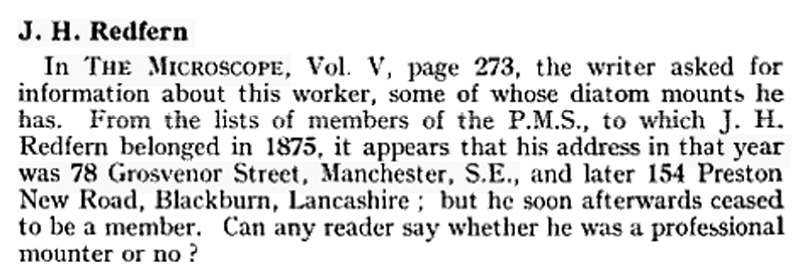
Figure 4.
Editor’s note from ‘The Microscopist’, 1940. This
information was repeated in the brief comment on Redfern in Brian Bracegirdle’s
‘Microscopical Mounts and Mounters’.
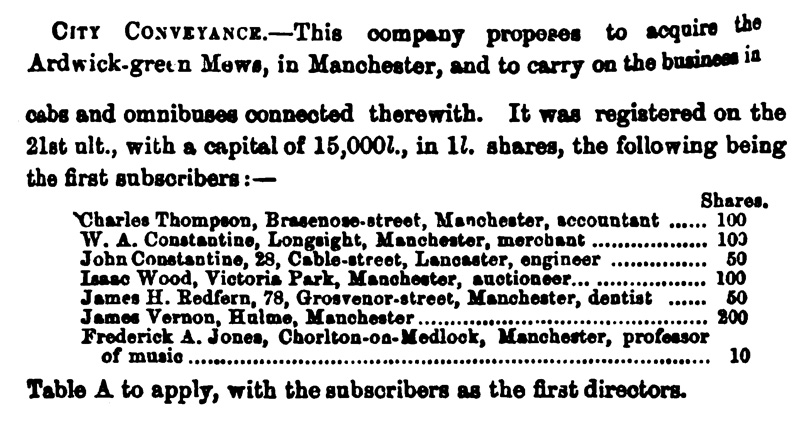
Figure 5.
A notice from ‘Capitol and Labour’, 1875. The
address of 78 Grosvenor Street, Manchester, identifies the slide-maker as
dentist James H. Redfern.
James Howard Redfern was born April 14, 1838 in Bury, Lancashire, north of Manchester. His father, also named James, was variously described in records as being a “flour dealer” and “provisions dealer”. The elder James married late in life, yet outlived three wives. When nearly 50, he married for the first time, to a widow named Alice Barnes. That Alice died in May, 1836, and James married a spinster named Alice Howard the following December. The second Alice was in her mid-20s when she married, while James was over 60. Alice died in May, 1840, when her son, the future microscopist James, was two years old. The father married a third time in 1844, to 38 year-old Barbara Ann Hill, who died in 1852. James senior died in 1861, when he was approaching 90.
The Redferns had the means and the interest in education to send James to boarding school. The 1851 census records the 13 year-old James as a boarding scholar in Taddington- Priestcliff, Derbyshire.
In addition to his business as an investor in the 1870s, James H. Redfern plied several trades. On his 1859 marriage record, James described his occupation as “druggist”. For the 1861 census, he listed himself as being a “druggist, dentist and clerk in a tarpawling warehouse” (tarpawling is tar-daubed heavy canvas used as waterproof covering for hatches on ships, and is the etymological precursor of the modern word tarpaulin).
The 1861 census also noted that James was a boarder, living in Chorlton-upon-Medlock, Lancashire. His wife, Elizabeth, and their 1 year-old son, James Henry, lived with Elizabeth’s parents and siblings in Hulme, Lancashire. Their son died in September, 1870, at the age of 11. Elizabeth died in March, 1873.
By the early 1870s, Redfern had acquired sufficient capital to make major investments. He invested in and became a director of the Lady Constance Lead Mining Company in August, 1873, and of the Duchess of Westminster Silver Lead Ore Company in May, 1874. As noted in Figure 4, above, he invested in the City Conveyance bus and taxi company in June, 1875. That same month, he invested in the Lancashire and Yorkshire Property Company, which “proposes to acquire land for building and other purposes”.
James remarried in early 1874, to the curiously named Jessie L’estrange Strange. Later that year, their son, Thomas Howard Redfern, was born.
For unknown reasons, the Redfern family moved frequently. In 1870 and ’71, they lived at 5 Alexandra Road, Moss Side, Lancashire. Records from 1873 give addresses of Stretford Road and 3 Dorset Street, both in Manchester. By May, 1874, they were at 78 Grosvenor Street, Chorlton-upon-Medlock. He also operated a druggist business from 23 Upper Jackson Street, Hulme prior to 1876.
Until the mid-1870s, Redfern’s major occupations were dentist and druggist. His dentistry may have led to his apparent interest in mounting diatoms. As described in detail in the biography of dentist/microscopist William Gatrell, diatomaceous earth was used as an abrasive in tooth-cleaning powders, and such powders were a popular source of diatoms for microscopy. Redfern’s membership in the Postal Microscopical Society date to his Grosvenor Street days, when he was an active dentist.
James Redfern may have been the man mentioned by George E. Davis in his 1889 Practical Microscopy, “When we come to compare the slides of diatoms put up by Cole, Redfern, or Redmayne, with many home-mounted slides it may be readily seen what is the effect of a little care on the part of the preparer. Cole's exceedingly clean gatherings, his hand-picked slides, Redfern's single diatom, mounted on a 1/4-inch cover in the centre of a red circle 1/16 of an inch in diameter, and Redmayne's diatom slides all deserve imitation.” Alternatively, Davis may have been referring to Peter Redfern (see below).
Redfern gave up his druggist business by 1876, and may also have given up dentistry at the same time. The November 25, 1876, issue of The Pharmaceutical Journal carried the following warning and a list of names that included Redfern, “We are requested by the Registrar to publish the following List of persons whose names will be erased from the Register unless they communicate with him on or before 30th December next ... Redfern, James Howard 23 Upper Jackson Street, Hulme, Manchester”.
James Redfern turned to ministry. The 1881 census listed the family at 17 Granville Terrace, Blackburn, Lancashire, where James was an “Angel” in the Catholic Apostolic Church. This was a religious movement that began in the 1830s, and should not be confused with the Roman Catholic Church (as did the Redfern’s census-taker in 1891). The position of Angel is comparable to minister or bishop.
Later, the Redferns moved to London. The 1891 census located them in the Battersea area, and 1901 had them in Hackney. James continued to his investments; the 1895 History, Topography, and Directory of Derbyshire listed among the major property owners of Taddington, “Rev. James Howard Redfern, Battersea Park”. When James died on December 5, 1922, he had two addresses: Peckham House, Peckham Road, Peckham, Surrey and 119 Brondesbury Road, Kilburn, Middlesex. However, he left an estate of only £285.
In conclusion, all evidence indicates that James Howard Redfern was an amateur microscopist. He prepared and exchanged microscope slides during the mid-1870s, possibly into the 1880s.
__________________________________________________________
Peter Redfern, 1821-1912
Peter and James may have been related, in that Peter was born in Chesterfield, Derbyshire and James was born in nearby in Lancashire and had Derbyshire connections.
Peter Redfern published a number of works on microscopy, some of which were on diatoms. Primarily, though, he is remembered for his work on anatomy. Peter Redfern studied in Edinburgh, and earned his medical degree at London University in 1844. He then became Professor of Anatomy and Physiology in King's College, Aberdeen. While at Aberdeen, Redfern published important works on cartilage and wound healing. In 1860, he became Professor of Anatomy and Physiology in Queen's College, Belfast. He retired in 1893, and died in Donaghadee, Ireland, at the age of 91.
Among Peter Redfern’s publications on other aspects of microscopical studies are analyses of coal-like mineral found in Torbane Hill, Scotland, development of a microscope for observing organisms in aquaria, and an analysis of the water supplied by a London company. The latter book, coauthored with Edwin Lankester, included descriptions of diatoms in the water supply.
Peter Redfern acquired a reputation as a skilled mounter of diatoms. Jabez Hogg first described Redfern’s technique in his 1851 The Microscope, “Mr. Redfern has given us an excellent mode of isolating Naviculas and other test objects. He says: Having found the methods ordinarily employed very tedious and frequently destructive of the specimens, I adopted the following plan: Select a fine hair which has been split at its free extremity into from three to five or six parts, and having fixed it in a common needle-holder by passing it through a slit in a piece of cork, use it as a forceps under a two-thirds of an inch objective, with an erecting eye-piece. When the split extremity of the hair touches the glass-slide, its parts separate from each other to an amount proportionate to the pressure, and on being brought up to the object, are easily made to seize it, when it can be transferred as a single specimen to another slide without injury. The object is most easily seized when pushed to the edge of the fluid on the slide. Hairs split at the extremity may always be found in a shaving-brush which has been in use for some time. Those should be selected which have thin, split portions so closely in contact that they appear single until touched at their ends. I have also found entire hairs very useful when set in needle-holders in a similar manner, any amount of flexibility being given to them by regulating the length of the part of the hair in use." The 1851 table of contents listed “Professor Redfern on isolating Naviculae”, and later editions replaced “Mr. Redfern” with “Dr. Redfern” in the text. Note that James H. Redfern was only 13 when Hogg first published his book. William Carpenter, in his The Microscope and Its Revelations, also mentioned Peter Redfern’s split hair method. From Hogg’s description, it is possible that Peter Redfern was actually the diatom mounting Redfern who was mentioned by Davis in 1889.
Acknowledgements
Many thanks to Steve Gill for generously sharing biographical information on James Redfern.
Resources
Baptism record of James H. Redfern (1838) Parish records of St. John, Bury, Lancashire
Bracegirdle, Brian (1998) Microscopical Mounts and Mounters, Quekett Microscopical Club, London, page 79
Burial record of Alice Redfern (1836) Parish records of St. John, Bury, Lancashire
Burial record of Alice Redfern (1840) Parish records of St. John, Bury, Lancashire
Capital and Labour (1875) Investors and directors of City Conveyance and Lancashire & Yorkshire Property, Vol. 2, pages 270-271 and 289
Carpenter, William B. (1856) The Microscope and Its Revelations, Blanchard and Lea, Philadelphia, page 307
Davis, George E. (1889) Practical Microscopy, W.H. Allen & Co., London, page 384
The Dublin Journal of Medical Science (1913) In memoriam: Peter Redfern, Vol. 135, pages 236-240
England census, birth, marriage and death records, accessed through ancestry.co.uk
History, Topography and Directory of Derbyshire (1895) Taddington, T. Bulmer & Co., Derby, page 467
Hardwicke’s Science-Gossip (1875) Slides of micro-fungi, &c., well mounted, for all kinds of unmounted material - J.H. Redgern (sic), Grosvenor-street, Manchester, SE, Vol. 11, page 96
Hogg, Jabez (1851) The Microscope, The London Illustrated Library, London, page 231
Hogg, Jabez (1871) The Microscope, Eighth edition, G. Routledge and Sons, London, pages 435-436
Huddersfield Daily Chronicle (1874) Directors of the Duchess of Westminster Silver Lead Ore Company
Jackson’s Oxford Journal (1873) Directors of the Lady Constance Lead Mining Company
Journal of the Postal Microscopical Society (1882) List of members – J.H. Redfern was not included, Vol. 1
Lankester, Edwin and Peter Redfern (1852) Reports Made to the Directors of the London (Watford) Spring Water Company, on the Results of Microscopical Examinations of the Organic Matters and Solid Contents of Waters supplied from the Thames and Other Sources, Hughes, London
Manchester Times Saturday (1870) Obituary, “On the 14th inst., in his 11th year, James Henry, only child of James Howard Redfern, 5 Alexandra Road, Moss Side”
Marriage record of James Redfern and Alice Barnes (1823) Parish records of St. Mary the Virgin, Bury, Lancashire
Marriage record of James Redfern and Alice Howard (1836) parish records of Manchester Cathedral
Marriage record of James Howard Redfern and Elizabeth Ada Wild (1959) Parish records of St. Mary, Bury, Lancashire
The Microscope (1940) J.H. Redfern, Vol. 6, page 296
The Pharmaceutical Journal (1876) Rectification of the registers of pharmaceutical chemists and chemists and druggists, Vol. 7, page 436
Probate record of Elizabeth Ada Redfern (1873) “(wife of James Howard Redfern) late of 3 Dorset Street, Stretford, in the County of Lancaster who died 25th March 1873 at 6 Hankinson Street, Derby Street, Hulme, Manchester in the said County was granted at Manchester to the said James Howard Redfern of 3 Dorset Street, Surgeon Dentist”
Probate record of James Redfern (1861) “late of Bury in the County, of Lancaster, Shop-Keeper, deceased, who died 29th September 1861 at 59 Stanley Street, Bury aforesaid was proved at the Principal Registry by the oaths of John Webster of Blackwell near Taddington in the County of Derby, Farmer and Robert Thornhill of Longstone near Bakewell in the same County, Farmer, two of the Executors”
Probate record of James Howard Redfern (1922) “of Peckham House Peckham-road Peckham Surrey and of 119 Brondesbury-road Kilburn Middlesex died 5 December 1922 at Peckham House Probate London 27 December to Thomas Howard Redfern solicitor. Effects £285 13s 8d”
Redfern, Peter (1854) On the nature of the Torbanehill and other varieties of coal, Quarterly Journal of Microscopical Science, Vol. 3, pages 106-127
Redfern, Peter (1858) On a simple method of applying the compound microscope to the upper or lateral surfaces of aquaria, Quarterly Journal of Microscopical Science, Vol. 6, pages 156-159